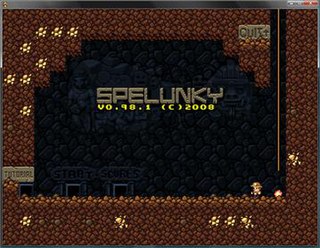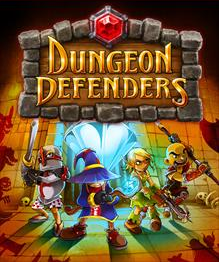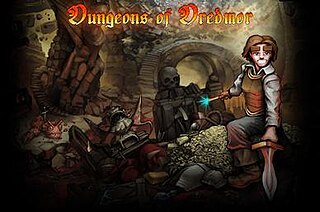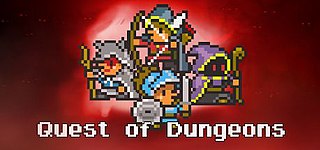
Roguelike is a style of role-playing game traditionally characterized by a dungeon crawl through procedurally generated levels, turn-based gameplay, grid-based movement, and permanent death of the player character. Most roguelikes are based on a high fantasy narrative, reflecting their influence from tabletop role-playing games such as Dungeons & Dragons.

Spelunky is a 2008 source-available 2D platform game created by independent developer Derek Yu and released as freeware for Microsoft Windows. It was remade for the Xbox 360 in 2012, with ports of the new version following for various platforms, including back to Microsoft Windows. The player controls a spelunker who explores a series of caves while collecting treasure, saving damsels, fighting enemies, and dodging traps. The caves are procedurally generated, making each run-through of the game unique.

Dungeon Defenders is a hybrid multiplayer video game developed by Trendy Entertainment that combines the genres of tower defense and action role-playing game. It is based on a showcase of Unreal Engine 3 named Dungeon Defense. The game takes place in a fantasy setting where players control the young apprentices of wizards and warriors and defend against hordes of monsters. A sequel titled Dungeon Defenders II was released in 2015.

Dungeons of Dredmor is a roguelike indie video game released on July 13, 2011, by Gaslamp Games. A downloadable content (DLC) pack, "Realm of the Diggle Gods", was released later that year. A second DLC, "You Have To Name The Expansion Pack", was released on June 5, 2012, and a third, "Conquest of the Wizardlands", was released on August 1, 2012. The game has extensive support for user-created modifications.

The Binding of Isaac is a roguelike video game designed by independent developers Edmund McMillen and Florian Himsl. It was released in 2011 for Microsoft Windows, then ported to OS X, and Linux. The game's title and plot are inspired by the Biblical story of the Binding of Isaac. In the game, Isaac's mother receives a message from God demanding the life of her son as proof of her faith, and Isaac, fearing for his life, flees into the monster-filled basement of their home where he must fight to survive. Players control Isaac or one of the 6 other unlockable characters through a procedurally generated dungeon in a roguelike manner, fashioned after those of The Legend of Zelda, defeating monsters in real-time combat while collecting items and power-ups to defeat bosses and eventually Isaac's mother.

Crypt of the NecroDancer is a roguelike rhythm game by Brace Yourself Games. The game takes fundamental elements of a roguelike dungeon exploration game and adds a beat-matching rhythm game set to an original soundtrack written by Danny Baranowsky. The player's actions are most effective when moving the character set to the beat of the current song and are impaired when they miss a beat, so it is necessary to learn the rhythmic patterns that the various creatures follow. The mixed-genre game includes the ability to import custom music, and the option to use a dance pad instead of traditional controllers or the keyboard. The game was released for Linux, OS X, and Windows in April 2015, being co-published by Klei Entertainment, for the PlayStation 4 and Vita in February 2016, for the Xbox One in February 2017, and for Nintendo Switch in February 2018. Crypt of the NecroDancer Pocket Edition, developed for iOS, was released in June 2016.

Legend of Dungeon is an indie roguelike action role-playing video game by Robot Loves Kitty for Microsoft Windows, OS X and Linux. The goal of the game is for players to fight through 26 monster filled levels, grab the treasure, then make it back through all 26 levels without dying. Legend of Dungeon also features a unique artstyle and atmosphere by blending pixelated characters in a 3D world as well as having both a dynamic shadow and music system.

Dungeon of the Endless is a roguelike tower defense game developed and published by Amplitude Studios. It is the third game of their loosely connected Endless series, which includes Endless Space and Endless Legend. It was released in October 2014 for Microsoft Windows and OS X, August 2015 for iOS, and for Xbox One in March 2016. The PlayStation 4 and Nintendo Switch ports were released in May 2020. A revamped version for iOS and Android devices, called Dungeon of the Endless: Apogee, was released in March 2021 by Playdigious.

Quest of Dungeons is a roguelike video game released on March 25, 2014 by Portuguese developer Upfall Studios. The game has graphics resembling 16-bit game consoles. It was initially released for Windows, Mac, and iOS, then for Xbox One via ID@Xbox on September 7, 2015. In February 2016, it was announced that the game was being developed for Wii U and Nintendo 3DS and was released on September 29, 2016. It was later released for PlayStation 4 on January 17, 2017. On August 2, 2017, it was announced that it would be coming to the Nintendo Switch.
Enter the Gungeon is a 2016 bullet hell roguelike game developed by Dodge Roll and published by Devolver Digital. Set in the firearms-themed Gungeon, gameplay follows four player characters called Gungeoneers as they traverse procedurally generated rooms to find a gun that can "kill the past". The Gungeoneers fight against bullet-shaped enemies, which are fought using both conventional and exotic weapons. Enter the Gungeon features a permadeath system, causing the Gungeoneers to lose all obtained items and start again from the first level upon death. Between playthroughs, players can travel to an area called the Breach, where they can converse with non-player characters and unlock new items randomly encountered while playing.

Monster Boy and the Cursed Kingdom is a 2018 platform game developed by Game Atelier and published by FDG Entertainment. Part of the Wonder Boy series, it was released for Nintendo Switch, PlayStation 4 and Xbox One in December, for Windows in July 2019, for Stadia in July 2020, for PlayStation 5 in December 2021, and for Xbox Series X/S in August 2022. It was generally well received by critics.

Risk of Rain 2 is a roguelike third-person shooter developed by Hopoo Games and published by Gearbox Publishing. A sequel to 2013's Risk of Rain, it was released in early access for Microsoft Windows, Nintendo Switch, PlayStation 4, and Xbox One in 2019 before fully releasing in August 2020 with a release for Stadia coming a month later.

Dead Cells is a 2018 roguelike-Metroidvania game developed by Motion Twin and Evil Empire, and published by Motion Twin. The player takes the role of an amorphous creature called the Prisoner. As the Prisoner, the player must fight their way out of a diseased island in order to slay the island's King. The player gains weapons, treasure and other tools through exploration of the procedurally-generated levels. Dead Cells features a permadeath system, causing the player to lose all items and other abilities upon dying. A currency called Cells can be collected from defeated enemies, allowing the player to purchase permanent upgrades.

Slay the Spire is a roguelike deck-building game developed by the American indie studio Mega Crit and published by Humble Bundle. The game was released in early access for Microsoft Windows, macOS, and Linux in late 2017, with an official release in January 2019. It was released for PlayStation 4 in May 2019, for Nintendo Switch in June 2019 and for Xbox One in August 2019. An iOS version was released in June 2020, with an Android version released in February 2021.

Dicey Dungeons is a roguelike deck-building game developed by Irish game designer Terry Cavanagh. It was released for Microsoft Windows, macOS, and Linux in August 2019, for Nintendo Switch in December 2020, for Xbox One and Xbox Series X/S in November 2021, and for PlayStation 4 and PlayStation 5 in February 2023. Ports for iOS and Android were released in July 2022.

UnderMine is a roguelike action dungeon crawler video game developed and published by Thorium. It was released for Microsoft Windows and Xbox One on August 6, 2020, which followed an early access release one year earlier. Nintendo Switch and PlayStation 4 versions were released in February and March 2021, respectively.

Mistover is a 2019 roguelike dungeon crawler role-playing video game developed and published by Krafton for Microsoft Windows, Nintendo Switch, and PlayStation 4. Mistover is set in a ravaged world recovering from a mass invasion of monstrous creatures from another realm, and its storyline follows the journey of a party of adventuring heroes who are on a quest to discover the source of the invasion. Players navigate environments from an isometric perspective with a party of procedurally generated player characters drawn from a roster of eight character classes to fight monsters and acquire loot recovered from the exploration of levels. A phenomenon known as "mist" is prevalent throughout the game world and negatively influences its characters, monsters, and items.

For the King is a roguelike role-playing video game developed by Canadian game developer IronOak Games and published by Curve Games. It was released in February 2017 to early access on Steam with a full release in April 2018. Gameplay revolves around exploration, clearing dungeons, and collecting new gear and weapons across the fictional land of Fahrul, with both co-op and single-player modes being available. A sequel, For the King II, was released on November 2, 2023.

Wildfrost is a 2023 roguelike deck-building game developed by Deadpan Games and Gaziter. It was published by Chucklefish for the Nintendo Switch and Windows, and in 2024 for Android and iOS.

Caveblazers is a 2017 video game developed by Deadpan Games and published by Yogscast Games. Described as an "action-focused roguelike platformer", players in Caveblazers defeat enemies across runs of procedurally-generated dungeons to accumulate items, weapons, and potions with random effects. The developers described the design of the game as aiming to "move away from the simplistic combat systems" of other roguelike games to focus on "fast-paced combat". Upon release, the game received generally favorable reviews, with praise directed to the game's roguelike mechanics, customisation and challenging difficulty, and criticism for its lack of variety of environments and enemies. A port of the game for the Nintendo Switch was released in 2019.





















